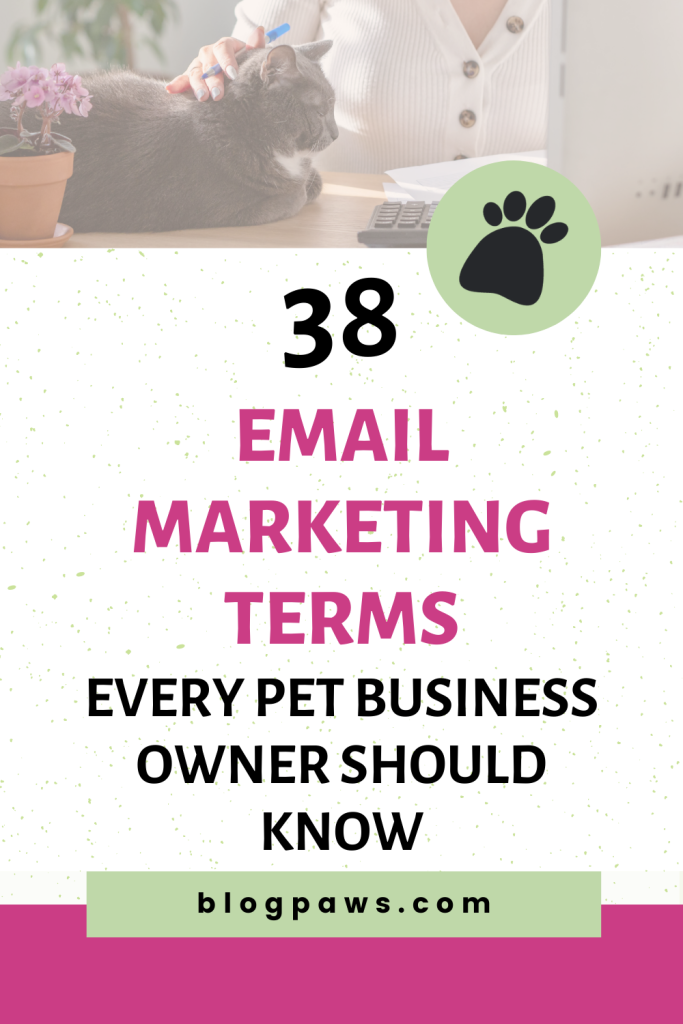38 Email Marketing Terms Every Pet Business Owner Should Know
Contrary to what some may think, email marketing is NOT dead. In fact, it is one of the best ways to grow and nurture your audience. That being said, with all the email marketing terms that are tossed around, it’s easy to feel lost.
What’s a CTA? Or a hard bounce? What about KPIs? Are these things you even need to be worrying about?!
The answer is “yes,” and the good news is we are here to help! After reading through this email marketing glossary, you will have a strong grasp of the most important email marketing terms so you can leverage them all for a better email strategy.
What are the Parts of an Email?
First things first – you want to make sure you have an understanding of the different parts of an email. The following email marketing terms all refer to things you want to include in each email you send. They are essentially the building blocks of your emails!
- Subject Line = the single line of text that people first see when your email arrives in their inbox
This is arguably the most important part of your email because it is what will grab the reader’s attention and entice them to open your email. You could have sent the best email ever, but if no one is opening it, it doesn’t matter. - Pre-Header Text = the short text snippet that directly follows the subject line when an email is seen in an inbox.
This will give your reader a little bit more information about what they can expect to find in your email. It is typically one sentence long and should work along with your subject line to encourage the reader to open your email. - E-mail Body = the actual text of your email message, which is seen once the reader opens your email
- Call to Action (CTA) = the action you are asking the reader to take
Every email should have a clear CTA. Examples include asking the reader to follow a link, make a purchase, sign up for something, reply to the email, follow you on social media, share something, etc. The CTA should be obvious so the reader is not confused about their next step, and you typically only want to have one CTA per email. - Signature = the personalized text that comes at the end of the email
Your email signature should at least include your name so the reader knows who the message is coming from. It can also include a branded closing phrase, such as “Happy Adventuring!” or “Purrs and nose bumps from…” Depending on the situation, you may want to include relevant contact information as well. - Email Footer = the block of text that comes at the very bottom of your email, after the body text and signature
The email footer typically includes elements such as your logo, business contact info, social media links, or legal disclaimers. It should also always include an unsubscribe link. - Unsubscribe Link = the button a reader clicks to unsubscribe from your email list
Though we all obviously hope our subscribers stick around, you still want to be sure to always include a way for them to unsubscribe in every email you send. It’s actually against the law to NOT include one (more on that later).
What are the Elements of an Email Marketing Strategy?
Okay, so now that you’ve gotten a handle on the basic parts of an email, it’s time to dig a bit deeper into email marketing terminology. The following terms are ones you may have heard thrown around before, but there may even be some new-to-you terms as well.
While they may not all be important or applicable to you today, they may become so as your business grows. You’ll want to at least have a basic understanding of what these email marketing terms mean so you can then make an educated decision about whether or not you should worry about them now or not.
- A/B Testing = the process of sending one version of your email to a section of your subscribers and a different version to another section to determine which version performs the best. Also known as “split testing.”
With A/B Testing, you may be trying to test out things such as which email subject gets the most opens or which CTA gets the most clicks. The best A/B tests only test one element at a time. - Anchor Text = the clickable text in a hyperlink (ex: the linked sentence right in the A/B testing definition)
- Bounce Rate = the percentage of email addresses in your subscriber list that your email could not be delivered to
Your email could not have been delivered for a variety of reasons – invalid email addresses, someone’s inbox is full, your email is perceived as spammy by your subscribers’ email client, etc. There are two different types of bounces – hard bounce and soft bounce (see definitions for each below) - Buyer Persona = a characterization or description of your ideal customer or target audience
Once you have an idea of your buyer personas (yes, you may have more than one), you can create more personalized email campaigns, which will increase conversions and clicks - Click-Through-Rate (CTR) = the percentage of email recipients who clicked on at least one link in your email campaign
This percentage usually isn’t very high, but don’t be discouraged by that unless yours is well below your industry standard. Check out this article for stats on average CTRs for various industries. - Conversion Rate = the percentage of subscribers who complete a goal action after opening and reading your email
Essentially, it’s the percentage of your subscribers who followed through on the CTA you included in your email (see the above section for CTA definition) - Deliverability = the ability of an email message to arrive in your subscribers’ inboxes
Even if your emails are being sent (not bouncing), they might be landing in your subscribers’ spam or promotions folders instead of their actual inboxes. This indicates an issue with deliverability. You can improve deliverability by verifying your domain through your email provider, sending from a verified domain email, including an unsubscribe link in your emails, keeping your email list cleaned up, and using double opt-in. - Delivery Rate = the percentage of emails that are sent to your subscribers and not returned as a hard or soft bounce
Delivery rate doesn’t account for emails that land in your subscribers’ spam folders, so it is possible to have a great delivery rate but still have poor deliverability (i.e. you aren’t getting many bounced emails, but your emails are still landing in many of your subscribers’ spam folders) - Email Campaign = the email (or a series of emails) sent to your subscriber list
- Email List = the list of people who have opted in to receive your email campaigns
- Geotargeting = the practice of sending different content to different subscribers based on their geographical location
- Hard Bounce = an email that has failed to be delivered for permanent reasons
Once an email address gets flagged as a hard bounce, it is typically wiped from your email list immediately. The most common reason for a hard bounce is an incorrect email address. - Key Performance Indicators (KPI) = measures of the performance of different aspects of your email campaign
The KPIs that matter most to you may change over time depending on your goals. Examples of KPIs include your open rate, click-through rate, or unsubscribe rate. Whichever ones you decide to focus on, you want to make sure you’re tracking them so you can get a clearer idea of whether or not you’re seeing success and growth. - Lead Magnets = the thing you are offering in exchange for someone signing up for your email list
To encourage people to subscribe to your list, you should be offering at least one lead magnet. Examples of a lead magnet include a free checklist or guide, a discount code, a free trial of something, access to exclusive material, etc. Whichever type of lead magnet you decide on, it should be seen as valuable by your ideal subscriber. - List Segmentation = the process of breaking up an email list into several smaller, more targeted lists
Segmenting your email list allows you to give your subscribers a more personalized experience, which will result in higher conversions. You may decide to segment your list based on your customers’ purchase histories, which services or products they are most interested in, the lead magnet they signed up for, etc. - Marketing Funnel = the path a subscriber takes to go from a prospective lead to a customer through educational and promotional email communications
A successful marketing funnel will take someone from being aware of who you are to engaging with your content, to making a purchase, to being a super-fan - Open Rate = the percentage of email recipients who actually opened your email
- Opt-In Rate = the percentage of site visitors who subscribe to your email list
- Personalization = using subscriber data within your email content to make it seem made for the individual
Personalizing emails has been shown to increase open and click-through rates. An easy way you can personalize your email campaigns is to use the subscriber’s first name in your subject line and email body. - Plain Text Email = a version of your email campaign that contains only plain text – no images, special fonts, hyperlinks, etc.
- Soft Bounce = an email that is temporarily undeliverable, usually due to an issue on the recipient’s end
An example of a soft bounce would be if a subscriber’s email inbox is full and can’t receive more messages. An email usually has multiple chances to soft bounce before eventually being flagged as a hard bounce and being removed from your email list. - Targeting = sending specifically targeted and personalized email campaigns to subscribers based on their characteristics, such as behavior, location, purchase history, etc.
- Unsubscribe Rate = the percentage of unsubscribes from an email campaign
- Welcome Email/Welcome Series = the first email or series of emails someone receives once they subscribe to your email list
Subscribers should receive their first welcome email immediately after subscribing. If they signed up for a lead magnet, the first welcome email should deliver that lead magnet to them.
Other Common Email Terms You Should Know
So now you are aware of the different parts of an email as well as the various terms that will help you build your specific email strategy. There are just a handful more miscellaneous email marketing terms you’ll likely come across at some point:
- Blacklist = a list that identifies IP addresses or domains that are known to send spam
Spoiler alert – you don’t want to get your email address blacklisted! Following best email practices will prevent that from happening. - CAN-SPAM = according to the FTC, the CAN-SPAM Act is “a law that sets the rules for commercial email, establishes requirements for commercial messages, gives recipients the right to have you stop emailing them, and spells out tough penalties for violations.”
Visit the FTC CAN-SPAM info page for an in-depth explanation so you can be sure you are operating within their laws. - Double Opt-In = adds an additional step to the email subscription opt-in process, requiring a user to verify their email address and confirm their subscription before you are able to send them email campaigns
If you have the double opt-in feature activated, once someone enters their email to subscribe to your list, they will first receive the confirmation email, which they will have to open and click to accept before they are officially added to your email list. While not required by law in the US, it is considered to be a best practice. It also helps to keep your email list from accumulating invalid and spam email addresses. - Email Service Provider (ESP) = the platform used to create and send email campaigns
- List Hygiene = cleaning up your email list to remove inactive or invalid subscribers
Regularly cleaning your email list will help improve your open and click-through rates. - Single Opt-In = only requires a subscriber to enter their email address on your initial subscribe form in order to be added to your email list
- Whitelist = the process of adding an email address to an approved sender list to prevent emails from that sender from going to spam folders
To help your subscribers guarantee they will always receive your emails in their inbox, you can ask them to whitelist your email address by adding it to their email contacts list.
We wouldn’t blame you if your head is spinning after reading through this list. It’s a lot, we know. Remember though that not all the terms on this list will necessarily be important to you. Maybe you don’t need to use or want to worry about list segmentation or geotargeting, for example. There’s nothing wrong with that!
While reading through this list and familiarizing yourself with these terms is certainly helpful, another way you can learn about all these things is by poking around in your email service provider dashboard. Look at your metrics and insights so you can see how these terms apply to you specifically. Then you can take the next step of crafting your specific email marketing strategy.
Do any of the terms on the list stand out to you as something you’d like to dig into deeper? What is the next step for you in your email marketing plan? We’d love to hear about it!
About the Author: Emily is the Director of Marketing and Community here at BlogPaws. She is also an online content creator and writer for her own site, KittyCatGO, as well as for Cat School. Emily is “mom” to 7 cats, 1 dog, and 2 sugar gliders. When she isn’t writing, playing music, or crocheting, Emily and her husband enjoy hiking, road-tripping, camping, and canoeing together with their 3 cat adventurers.






